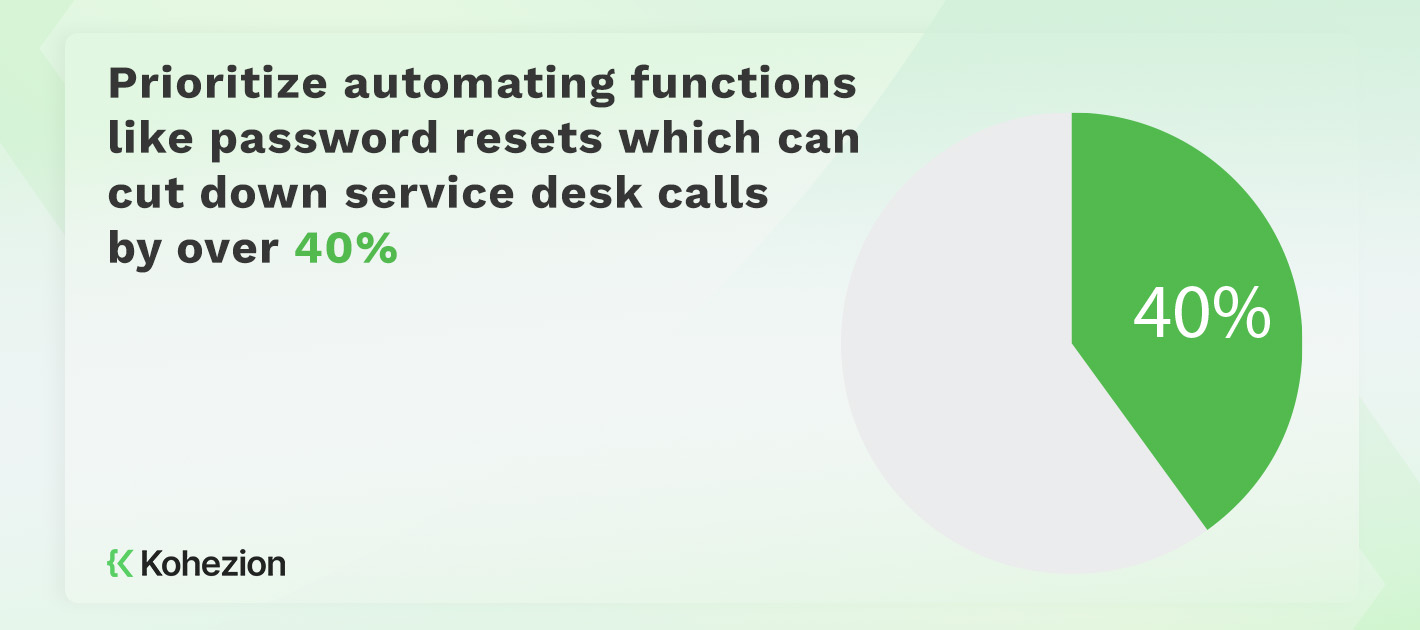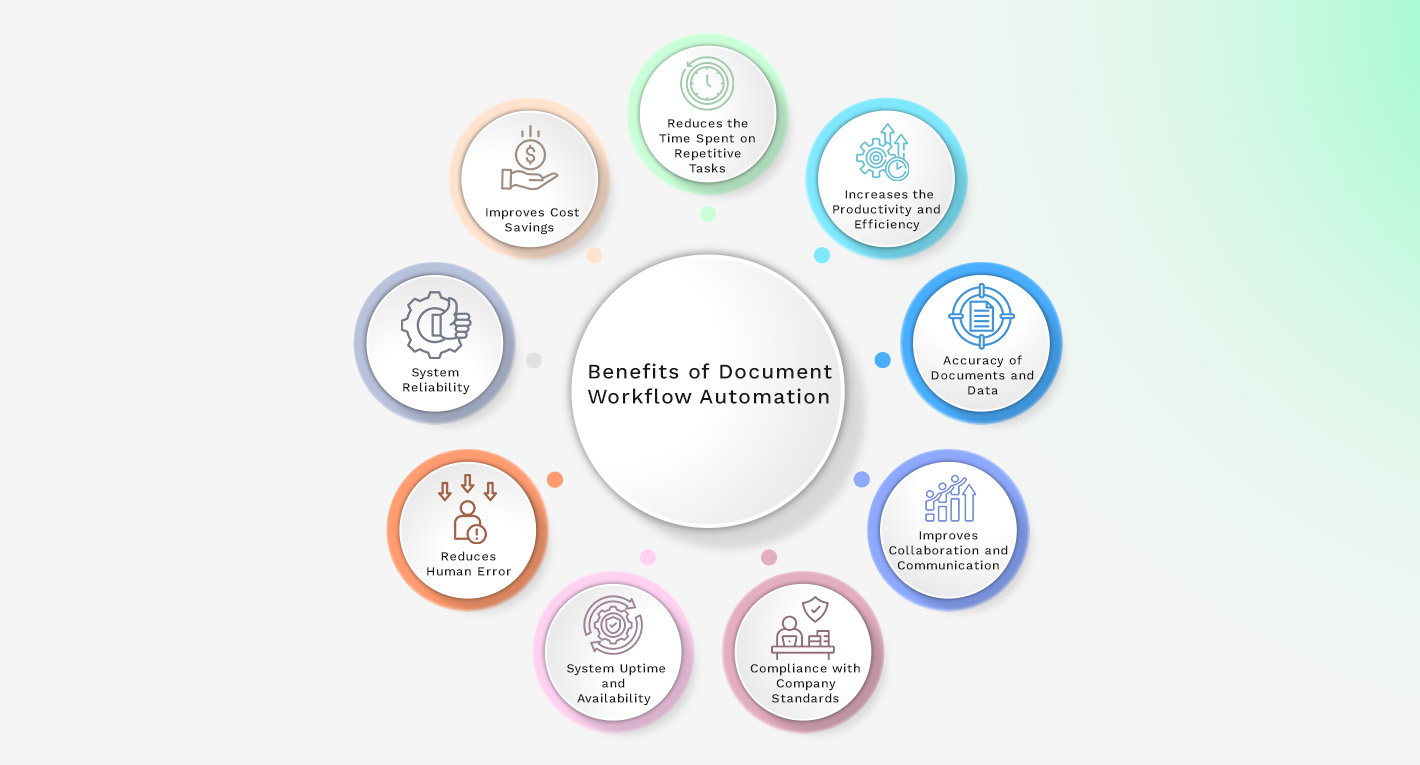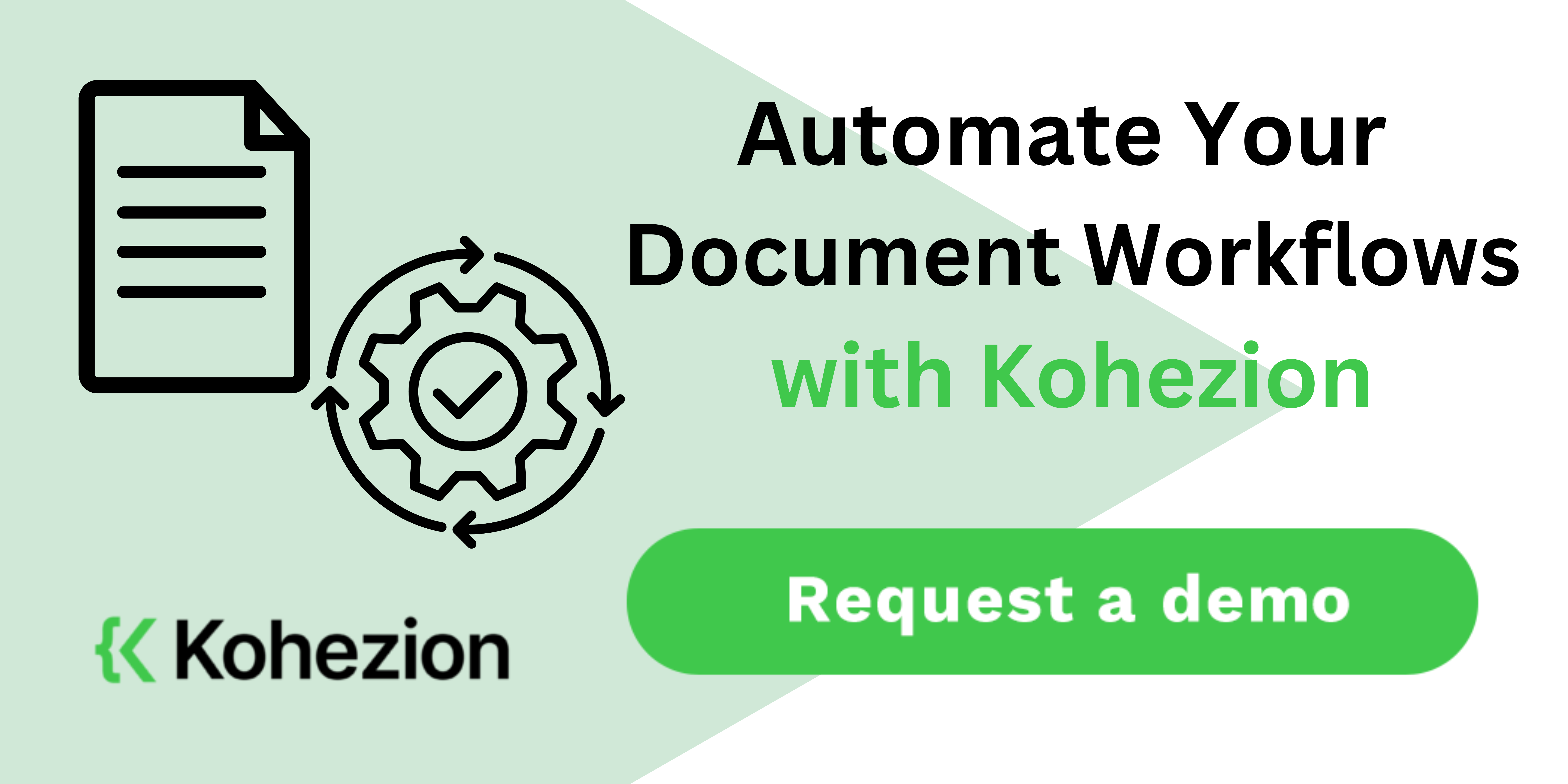Did you know that, on average, employees spend up to 20% of their workweek searching for and managing documents? This not only hampers productivity but also leads to errors and delays. At Kohezion, we understand the need for a streamlined document management system that saves time and resources. In this blog post, we'll explore document workflow automation, discuss its benefits, and provide insights into how it can transform your business processes.
What Is Document Workflow Automation?
Document workflow automation is a technology-led approach for managing and streamlining the flow of documents within an organization with minimal human intervention. This system uses software to automate repetitive document-centric tasks like sorting, delivering, archiving, and obtaining necessary signatures.
Document workflow automation ensures that the right documents get to the right people at the right time by integrating tools like electronic signatures, automated reminders, and CRM systems, thus creating an efficient process for all document-related activities.
Why Is Document Workflow Automation Important?
Document workflow automation helps businesses sustain a competitive advantage. Modern businesses digitize more processes daily, resulting in an increased volume of documents to handle. Without automation, this huge volume of files could lead to errors, delays, and ultimately, a hit to the company’s bottom line. Document workflow automation ensures that tasks are completed with precision and pace, protecting your organization against these pitfalls while securing data integrity.
Benefits of Document Workflow Automation
1. Reduces the Time Spent on Repetitive Tasks
According to research, workflow automation can reduce repetitive tasks by up to 95%. Document workflow automation makes tasks that were traditionally time-consuming and prone to procrastination—like data entry and document routing—faster and seamless. This speeds up the workflow and improves your team's morale, as they can dedicate time to more engaging and fulfilling tasks.
2. Increases the Productivity and Efficiency
According to statistics, adopting workflow automation resulted in less human error for over 30% of organizations, increasing their overall productivity and efficiency. Document workflow automation replaces the manual transfer and updating of documents with quick digital processes.
Files are circulated and updated in real-time, allowing your team to complete more tasks, quicker, and with fewer errors. This kind of efficiency also streamlines communication channels and reduces bottlenecks. Every task that's automated is one less thing to manage, freeing your team to focus on more important tasks.
3. Accuracy of Documents and Data
Automating workflows minimizes human error and increases data accuracy by 88% which is higher than any other document processing method. When data is entered, transferred, and stored by automated systems, the likelihood of typos, duplications, and omissions decreases.
Automated checks and validations also ensure that every piece of data meets your required standards before it's accepted into your system. This results in cleaner data, more reliable analytics, and informed decision-making.
4. Improves Collaboration and Communication
Employing document workflow automation allows multiple team members to work on documents at the same time while tracking changes and comments in real-time. This transparent and efficient communication streamlines decision-making processes and project management, bringing people and teams closer together. It also facilitates a collaborative culture that's adaptable and responsive, regardless of whether team members are working from the office or remotely.
5. Compliance with Company Standards
Document workflow automation also sets predefined rules and templates to ensure adherence to company standards and policies. The automation software monitors compliance, prompts users when actions are needed, and provides audit trails for accountability and regulatory purposes. This enforces a consistent approach to document management across the entire organization, upholding high standards without manual oversight.

6. System Uptime and Availability
Hosting your document management system in the cloud through providers like Microsoft Azure or AWS ensures that your system is always on and accessible globally. These cloud solutions make extensive downtime a thing of the past, guaranteeing an uptime that often exceeds 99.9%. This consistent availability means that your team can access necessary documents and continue their workflow without interruption.
7. Reduces Human Error
Around 34% of small and mid-sized businesses find workflow automation reduces mistakes. Document workflow automation minimizes the risk of human error by automating processes like data entry, version control, and task routing. Eliminating these errors helps you prevent the domino effect of troubleshooting and correcting them, which often consumes valuable resources and time. Maintaining accuracy not only saves costs but also protects the reputation of your business.
8. System Reliability
Document workflow automation provides reliability in document management, allowing access and work with necessary documents whenever needed. These systems are designed with fail-safes and redundancies to prevent data loss and ensure consistent performance.
Regular updates and maintenance are part of the service provider's responsibility, so you get a system that's always up-to-date without the added stress on your IT department. This reliability means your team can work confidently, knowing their tools are as robust and dependable as they need them to be.
9. Improves Cost Savings
Streamlining processes and reducing the demand for labor-intensive tasks allows you to allocate your budget more effectively. On top of that, cutting down on errors means less money spent on correcting issues. Since document automation often reduces the need for physical storage, printing, and paper costs, you'll find additional savings you might not expect.

Automate Your Document Workflows with Kohezion
Ready to take the next step toward operational excellence? Kohezion offers a robust, customizable document workflow automation platform that can revamp your document management from top to bottom. Transition into a paperless environment, fine-tune your processes, and enjoy the seamless integration that Kohezion provides.
Whether you're dealing with internal documents, customer-facing forms, or complex contractual workflows, Kohezion's platform can adapt to your unique requirements. And with its user-friendly interface, you can design and implement powerful automation without needing a degree in computer science.
Start your journey to a smarter workplace today with Kohezion and experience firsthand the transformative power of document workflow automation.
Conclusion
Document workflow automation is essential for organizations that aim to thrive in 2024 and beyond. Embracing this technology enables you to foster a culture of efficiency, accuracy, and collaboration. The benefits include reduced time spent on tedious tasks, improved productivity and document accuracy, better collaboration, and ensuring compliance.
Kohezion is your partner in this journey, offering a powerful and flexible solution tailored to your business needs. Say goodbye to manual work and welcome the efficient, cost-effective way of managing documents.
Start building with a free account
Frequently Asked Questions
"Document workflow" refers to the sequence of processes through which a document passes from initiation and creation to completion and storage. This includes drafting, editing, reviewing, approving, and archiving documents, and can be applied to any kind of document within a business's operations. It's the documented journey a file takes within an organization.
Automation streamlines your document processes by reducing manual handling, speeding up the flow of information, and increasing accuracy. It allows real-time tracking, easier retrieval, and better document management while also freeing up your team's time to focus on strategic tasks.
Absolutely, many document workflow automation solutions cater to specific industries, offering tailored functionalities that address unique regulatory, compliance, and operational requirements. For example, healthcare might require HIPAA-compliant software, while law firms might need secure e-signature capabilities. Identifying solutions that align with your industry's needs can significantly improve workflow efficiency and regulatory adherence.


